Related Research Articles

Set is a god of deserts, storms, disorder, violence, and foreigners in ancient Egyptian religion. In Ancient Greek, the god's name is given as Sēth. Set had a positive role where he accompanies Ra on his barque to repel Apep, the serpent of Chaos. Set had a vital role as a reconciled combatant. He was lord of the Red Land (desert), where he was the balance to Horus' role as lord of the Black Land.

Hindu deities are the gods and goddesses in Hinduism. Deities in Hinduism are as diverse as its traditions, and a Hindu can choose to be polytheistic, pantheistic, monotheistic, monistic, even agnostic, atheistic, or humanist. The terms and epithets for deities within the diverse traditions of Hinduism vary, and include Deva, Devi, Ishvara, Ishvari, Bhagavān and Bhagavati.

Religious practices in ancient Greece encompassed a collection of beliefs, rituals, and mythology, in the form of both popular public religion and cult practices. The application of the modern concept of "religion" to ancient cultures has been questioned as anachronistic. The ancient Greeks did not have a word for 'religion' in the modern sense. Likewise, no Greek writer known to us classifies either the gods or the cult practices into separate 'religions'. Instead, for example, Herodotus speaks of the Hellenes as having "common shrines of the gods and sacrifices, and the same kinds of customs."
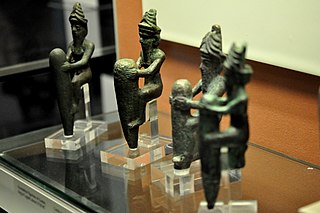
The Anunnaki are a group of deities of the ancient Sumerians, Akkadians, Assyrians and Babylonians. In the earliest Sumerian writings about them, which come from the Post-Akkadian period, the Anunnaki are deities in the pantheon, descendants of An and Ki, the god of the heavens and the goddess of earth, and their primary function was to decree the fates of humanity. They should not be confused with the Apkallu.
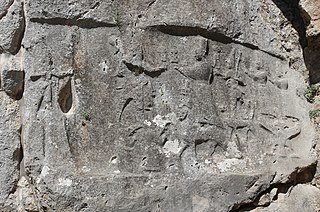
Ḫepat was a goddess associated with Aleppo, originally worshiped in the north of modern Syria in the third millennium BCE. Her name is often presumed to be either a feminine nisba referring to her connection to this city, or alternatively a derivative of the root ḫbb, "to love". Her best attested role is that of the spouse of various weather gods. She was already associated with Adad in Ebla and Aleppo in the third millennium BCE, and in later times they are attested as a couple in cities such as Alalakh and Emar. In Hurrian religion she instead came to be linked with Teshub, which in the first millennium BCE led to the development of a tradition in which she was the spouse of his Luwian counterpart Tarḫunz. Associations between her and numerous other deities are described in Hurrian ritual texts, where she heads her own kaluti, a type of offering lists dedicated to the circle of a specific deity. She commonly appears in them alongside her children, Šarruma, Allanzu and Kunzišalli. Her divine attendant was the goddess Takitu. In Hittite sources, she could sometimes be recognized as the counterpart of the Sun goddess of Arinna, though their respective roles were distinct and most likely this theological conception only had limited recognition. In Ugarit the local goddess Pidray could be considered analogous to her instead.

Pinikir, also known as Pinigir, Pirengir, Pirinkir, and Parakaras, was an Ancient Near Eastern astral goddess who originates in Elamite religious beliefs. While she is only infrequently attested in Elamite documents, she achieved a degree of prominence in Hurrian religion. Due to her presence in pantheons of many parts of the Ancient Near East, from Anatolia to Iran, modern researchers refer to her as a "cosmopolitan deity."
Pirwa, also known under the variant names Perwa and Peruwa, was a god worshiped by Hittites and Luwians in ancient Anatolia. He was associated with horses. There is also evidence that he was regarded as a warlike deity. He is first attested in documents from Kanesh, which mention a priest in his service. He retained his connection with this city in later sources, but he also came to be worshiped in a number of other locations, including Hattusa. A possible late reference to him occurs in a Neo-Assyrian text listing deities worshiped in Arbela, though this attestation remains uncertain and might be a scribal mistake.
The religions of the ancient Near East were mostly polytheistic, with some examples of monolatry. Some scholars believe that the similarities between these religions indicate that the religions are related, a belief known as patternism.

Armenian mythology originated in ancient Indo-European traditions, specifically Proto-Armenian, and gradually incorporated Hurro-Urartian, Mesopotamian, Iranian, and Greek beliefs and deities.
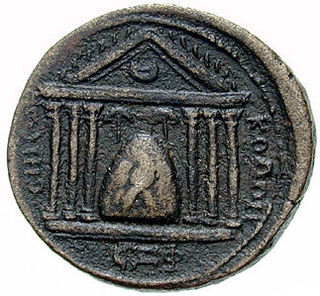
A baetyl, literally "house of God" is a sacred stone that was venerated and thought to house a God or deity. The most famous example is the Omphalos stored in the Temple of Apollo at the Greek town of Delphi.

Hittite mythology and Hittite religion were the religious beliefs and practices of the Hittites, who created an empire centered in what is now Turkey from c. 1600–1180 BC.

Minoan religion was the religion of the Bronze Age Minoan civilization of Crete. In the absence of readable texts from most of the period, modern scholars have reconstructed it almost totally on the basis of archaeological evidence of such as Minoan paintings, statuettes, vessels for rituals and seals and rings. Minoan religion is considered to have been closely related to Near Eastern ancient religions, and its central deity is generally agreed to have been a goddess, although a number of deities are now generally thought to have been worshipped. Prominent Minoan sacred symbols include the bull and the horns of consecration, the labrys double-headed axe, and possibly the serpent.
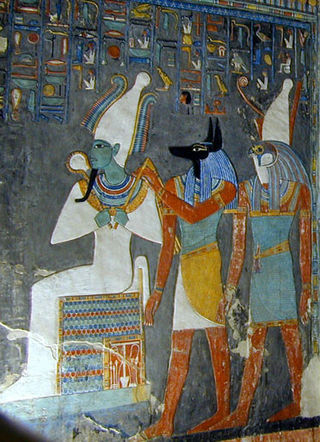
Ancient Egyptian deities are the gods and goddesses worshipped in ancient Egypt. The beliefs and rituals surrounding these gods formed the core of ancient Egyptian religion, which emerged sometime in prehistory. Deities represented natural forces and phenomena, and the Egyptians supported and appeased them through offerings and rituals so that these forces would continue to function according to maat, or divine order. After the founding of the Egyptian state around 3100 BC, the authority to perform these tasks was controlled by the pharaoh, who claimed to be the gods' representative and managed the temples where the rituals were carried out.
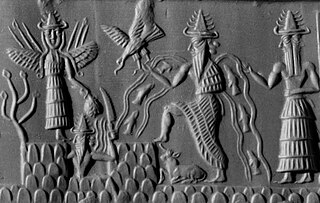
Isimud was a Mesopotamian god regarded as the divine attendant (sukkal) of the god Enki (Ea). He was depicted with two faces. No references to temples dedicated to him are known, though ritual texts indicate he was worshiped in Uruk and Babylon. He was also incorporated into Hurrian religion and Hittite religion. In myths, he appears in his traditional role as a servant of Enki.
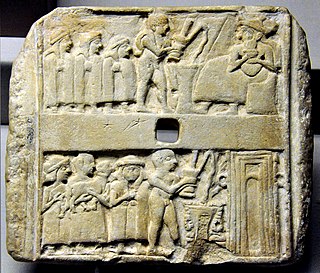
Sumerian religion was the religion practiced by the people of Sumer, the first literate civilization found in recorded history and based in ancient Mesopotamia. The Sumerians regarded their divinities as responsible for all matters pertaining to the natural and social orders.
Ḫatepuna or Ḫatepinu was a Bronze Age Anatolian goddess of Hattian origin, also worshiped by Hittites and Kaška. She was regarded as the wife of Telipinu, and like him was likely an agricultural deity. In a different tradition, her husband was the male form of the grain deity Ḫalki. It is presumed that she can be identified with the anonymous "daughter of the sea" who appears in two Hittite myths.

The Hurrian religion was the polytheistic religion of the Hurrians, a Bronze Age people of the Near East who chiefly inhabited the north of the Fertile Crescent. While the oldest evidence goes back to the third millennium BCE, it is best attested in cuneiform sources from the second millennium BCE written not only in the Hurrian language, but also Akkadian, Hittite and Ugaritic. It was shaped by contacts between the Hurrians and the various cultures with which they coexisted. As a result, the Hurrian pantheon included both natively Hurrian deities and those of foreign origin, adopted from Mesopotamian, Syrian, Anatolian and Elamite beliefs. The culture of the Hurrians was not entirely homogeneous, and different local religious traditions are documented in sources from Hurrian kingdoms such as Arrapha, Kizzuwatna and Mitanni, as well as from cities with sizeable Hurrian populations, such as Ugarit and Alalakh.

Pala was a Bronze Age country in Northern Anatolia. Little is known of Pala except its native Palaic language and its native religion. Their language shared common innovations with Luwian not present in the Hittite language suggesting a prior Luwian-Palaic linguistic complex.
Goddess of the Night (Sumerian: 𒀭𒈪, DINGIR.GE6) was a deity worshiped in the Hurrian kingdom of Kizzuwatna, and later also in Šamuḫa in the Hittite Empire. Only the logographic writing of her name is known, and multiple attempts at identifying her identity have been made. Most researchers assume that she was at least partially similar to goddesses such as Ishtar, Šauška and Išḫara. She most likely represented the night sky, and was also associated with dreaming.
Iyaya was a Hittite and Luwian goddess. Her functions remain uncertain, though it has been suggested she was associated with water or more broadly with nature. She might have been associated with the god Šanta, though the available evidence is limited. Her main cult centers were Lapana and Tiura, though she was also worshiped in other cities.
References
Citations
- ↑ Laneri 2024, p. 180.
- ↑ Marinatos 2010, p. 87.
- ↑ Bryce, Trevor (2002). Life and Society in the Hittite World. Oxford University Press. p. 156. ISBN 978-0-19-924170-5.
- ↑ Becchio, Bruno; Schadé, Johannes P. (2006). Encyclopedia of World Religions. Foreign Media Group. p. 429. ISBN 978-1-60136-000-7.
Sources
- Laneri, Nicola (2024). From Ritual to God in the Ancient Near East: Tracing the Origins of Religion. Cambridge University Press.
- Marinatos, Nanno (2010). Minoan Kingship and the Solar Goddess: A Near Eastern Koine. University of Illinois Press.